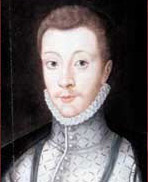Clan Stewart People
Henry Stewart, Lord Darnley (c.1545-67)
The eldest son of the 4th Earl of Lennox was raised in England as a Protestant during Elizabeth I’s reign. In Scotland, his besotted cousin Queen Mary gifted him the Earldom of Ross and the Dukedom of Albany, followed soon by her hand in marriage on the 29 July 1565.
Scottish nobles suspected his motives and were proven correct. His arrogance at once created great friction and in March 1566 he led a conspiracy that had David Rizzio, the Queen’s secretary and best friend, murdered before her.
After they had a son together, James VI, he began to plan how, through foreign support and changing his religion to Catholicism, he could take the Crown of Scotland from his estranged wife.
He was weakened by syphilis and could nut pursue his goals without first convalescing. While resting at Edinburgh’s Kirk o’Fields on 10 February 1567 the house was blown up. Darnley was found strangled in the garden.
Prince Charles Edward Stewart (1720-1788)
Prince Charles Edward Stewart was born in Rome in 1720. His father was “the Old Pretender”, James Francis Edward Stewart, son of James VII, his mother was Clementina Sobieski, grand-daughter of the King of Poland.
He had proven himself to be a young man of bravery, a gifted conversationalist and having taste in the arts. He began his reclamation of the Scottish Crown by pawning his jewellery and borrowing 180,000 livres to finance a force under the command of the Marechal de Saxe.
All was lost in a storm and he landed in Moidart with only seven men. Nonetheless his enthusiasm and bewitching words brought the Jacobite out in every man he talked with. With Lord George Murray as his general, he raised his standard on 19 August 1745 at Glenfinnan.
Victory followed at Edinburgh and Prestonpans against the Hanovarians. As they made for the border, the various motives for fighting that had woven the force together began to pull it apart. The Prince was not there for Scotland’s sake but to have the Highlanders assist him claim the crown of England.
Four of the seven men he had landed with were Irish and had their own agenda. They openly argued with Murray at every turn. Against Murray’s advice, the army moved south with the intention of taking London.
After taking Carlisle the Prince was advised to dismiss Murray. The Highlanders were with him however, so his dismissal was withdrawn. When the army reached Derby, about two-thirds of the way toward London, it was apparent that English Catholics were not interested in restoring the Stewarts.
With the growing danger of a Hanovarian force establishing themselves to the Jacobite rear by sea, a retreat was begun on 5 December. At Falkirk on their return the Jacobites once again defeated the Hanovarians.
Many Highlanders were now tired and Murray advised they should all disperse and regroup after the winter. Prince Charles’ judgement was being undermined by his ego. He spent time and energy in a futile attempt to capture Stirling Castle while “Butcher” Cumberland was on his way.
The Jacobites were at Inverness when Cumberland landed at the Spey. Culloden began with a tired and depleted Jacobite army, guerrilla fighters in an open field, and ended after an hour’s slaughter claiming two thousand of their lives.
As Stewart fled the battlefield, Lord Elcho’s last words were “There goes that damned Italian coward”. While Cumberland tortured Scots to death across the country, the Prince hid under the protection of Lady Margaret MacDonald of Sleat and Flora MacDonald.
He made it to France in September 1746.
Then in 1750 he secretly appeared in London declaring himself to be a Protestant. He married the Princess Louise of Stolberg in 1772 while she was not yet twenty and he was a fifty-two year old alcoholic woman-beater.
He died in his hometown of Rome.
Sir Thomas Grainger Stewart (1837-1900)
Edinburgh born and educated, Grainger Stewart furthered his knowledge of the body at Vienna, Berlin and Prague before returning to Edinburgh to be the House Physician of the Royal Infirmary. He moved on to be the Infirmary’s Pathologist and a Lecturer in the field. A knighthood followed his appointment as Queen Victoria’s physician.
His publications, “Practical Treatise on Bright’s Disease” and “Diseases of the Nervous System”, were influential in the understanding the treatment of the afflictions they addressed. Having climbed to the top of the medical world, he died as President of the Edinburgh Medical Missionary Society.
David Stewart (1772-1829)
As a soldier, Stewart served with the 42nd and 78th Highlanders where he rose to Major-General through his actions in Egypt and the West Indies. He is best remembered however as a writer. His 1822 work, “Sketches of the Characters, Customs, and Present State of the Highlanders of Scotland”, was the foundation on which the works of many others studying the clans was based. He was the Governor of St Lucia when he dies of fever.
Quick Links to Clan Stewart Products from The Clan Shop
- Stewart Tartan Tie
- Stewart Tartan Pocket Square Handkerchief
- Stewart Tartan Scarves
- Stewart Tartan Kilts
- Stewart Clan Crest Badge
- Stewart Clan Crest Mug
- Stewart Clan Crest T-Shirts
- Stewart Clan Crest Belt Buckle
- Stewart Phone Covers
- Stewart Tartan
- Stewart Clan Crest Crystal Glasses
- Stewart Clan Crest Cufflinks
- Stewart Clan Crest Sgain Dubh
- Stewart Clan Crest Kilt Pin
- Stewart Clan Crest Plaques







